
5 |
Text by Paul Skelton |
|---|---|
The streams, rivers and dams of southern Africa contain a wide variety of both indigenous and alien fishes, totalling about 370 species in 37 families. The majority of these are tropical (80%, about 300 species), with relatively few (14%, about 53 species) found in temperate waters. Very few freshwater fishes in southern Africa are tolerant of brackish and sea water, but several species of mainly marine groups, like gobies and sleepers, occur in fresh water (about 6%, or 25 species). These include the freshwater eels, which are diadromous (breed at sea, but live their post-larval lives in fresh water). In this section two measures are used to indicate size: standard length (SL), which is measured from the tip of the snout to the end of the caudal (tail) skeleton and excludes caudal fin rays (the thin cartilaginous supporting structures in fish fins), and total length (TL), which includes the caudal fin rays. The diagram below shows other key features used to identify fishes.

African lungfishes
Family Protopteridae
Lungfishes are part of an ancient lineage that includes the tetrapods (all amphibians, reptiles, birds and mammals), and members of this group of vertebrates are the closest relatives of all other bony fishes. There are four species of lungfish in Africa, all distributed in tropical waters. All have lungs, are compulsory air-breathers, and aestivate in mucous cocoons, which they secrete, allowing them to survive in the mud when the water body dries out.
1 East-coast lungfish
Protopterus annectens


© R. BILLS
Elongate and soft-bodied with long soft dorsal and anal fins joined to form a pointed tail, paired thread-like pectoral and pelvic fins, and cloaca (excretory opening) offset to one side. Python-like head has prominent lateral-line canals. Size: Up to 600mm TL. Biology: Lives in swamps, temporary pans and slow-flowing rivers. Breathes air, surviving habitat desiccation by burrowing and forming a cocoon in the mud. Preys on molluscs and other slow-moving invertebrates, fishes, tadpoles and frogs. Male guards the nest.
Snoutfishes
Family Mormyridae
A large family of about 216 species of peculiar African tropical freshwater fishes that have the ability to generate and receive electric signals, which are used for a variety of functions, especially communication. Each species has its own characteristic electric discharge, and this can be used to identify the species.
2 Cornish jack
Mormyrops anguilloides


© M. ARNEGARD
Elongated, with large head and terminal mouth. Soft dorsal and anal fins placed far back on the body, with dorsal shorter than anal fin. Caudal fin relatively small and lobe-like. Size: Attains 1.2m TL, 15kg. Biology: Inhabits deep water in large rivers and lakes. Juveniles feed on invertebrates; adults (>170mm SL) prey on fishes, sometimes hunting in packs. Long-lived, attaining around eight years. Generates weak electric current to detect objects and to communicate.
3 Western bottlenose
Mormyrus lacerda


© P. SKELTON
Elongated, with extended dorsal fin longer than short anal fin. Snout deflected and tubular. Size: Attains 500mm SL, 2kg. Biology: Prefers quiet habitats, such as floodplain lagoons and deep channels. Feeds on insects, shrimps, snails and small fishes from soft bottom muds. Produces weak electric discharge. RELATED SPECIES: Eastern bottlenose (M. caschive) from the middle and lower Zambezi has a more extended recurved snout.
1 Bulldog
Marcusenius macrolepidotus
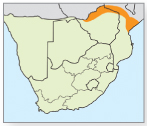

© P. SKELTON
Body compressed and oblong, with slender caudal peduncle. Dorsal fin shorter than anal fin; ‘chin’ lobe-like. Colour variable. Size: Usually <150mm SL, but can reach 300mm SL. Biology: They shoal and migrate to breed in early summer, forming target prey for predatory fishes like the Sharptooth catfish (Clarias gariepinus) (p.114, 1) and Tigerfish (Hydrocynus vittatus) (p.110, 5). Males pair with females, and eggs are scattered around spawning site. Communicate using both sounds and weak electric current.
2 Slender stonebasher
Hippopotamyrus ansorgii


© P. SKELTON
Elongate slender body with dorsal fin shorter than anal fin and placed far back on body. Dark vertical bar across flanks between anterior origin of dorsal and anal fins. Mouth with distinct lobe-like ‘chin’. Size: Reaches 150mm SL. Biology: Produces intermittent bursts of weak electric current. Found in rocky habitats or among plant roots along river banks. Feeds on invertebrates.
3 Southern Churchill
Petrocephalus wesselsi


© P. SKELTON
Has short ovoid body and rounded head, with non-terminal mouth below eyes, closely positioned external nostrils and dorsal fin slightly shorter than anal fin. Male has kink in anal fin. As with other electric fishes, size of electric field approximately 1m in radius. Size: Up to 120mm SL. Biology: More diurnal than other mormyrids. Shoals; male territorial and produces sounds (‘hoots’) as well as electric pulses in establishing and defending territory. RELATED SPECIES: Northern Churchill (P. catostoma) from Tanzania, and P. petersi in lower Zambezi River differ in the form of their electric pulses and in fin ray counts.
4 Dwarf stonebasher
Pollimyrus castelnaui


© P. SKELTON
Has ovoid body, round head with eyes far forward and small terminal mouth. Dorsal fin slightly shorter than anal fin. Caudal peduncle slender. Mottled dark and light brown. Size: Reaches 70mm SL. Biology: Inhabits a wide range of habitats from rocks to dense reeds, floating vegetation and plant roots along river banks. Feeds on small invertebrates. Uses both sounds and electric pulses to communicate. Male constructs and defends a nest and guards the eggs. RELATED SPECIES: P. marianne from the Zambezi, and P. cuandoensis from the Kwando River differ in the form of their electric pulses and in their morphology.
Freshwater eels
Family Anguillidae
Very long sinuous fishes adapted for burrowing or living in crevices and gaps between rocks and holes. There are 15 freshwater eel species globally, with four in East African coastal rivers. All are catadromous (breed at sea in ocean gyres, i.e. large circular currents), the eggs and specialised, transparent, leaf-like larvae known as leptocephali being carried to shore as plankton in ocean currents. There the larvae metamorphose into elvers (young eels), enter estuaries and ascend rivers, where they live and feed for 8–20 years, depending on sex and species.
5 Longfin eel
Anguilla mossambica


© B. ELLENDER
A long and sinuous eel, with large mouth, sharp teeth, soft skin and minute scales. The dorsal, caudal and anal fins are confluent; lacks pelvic fins. Size: Reaches 1.2m TL. Biology: Nocturnal, living in crevices and between rocks or buried in soft sediments. Preys on aquatic insects and invertebrates and, when larger, crabs, frogs and fishes. Male remains in fresh water for 8–10 years, female 15–20 years. A recent study indicates A. mossambica is distantly related to all other Anguilla species.
Freshwater sardines
Family Clupeidae
Although most clupeids are marine, there are about 40 freshwater species in Africa. These small silvery fishes are midwater shoalers with light deciduous (tending to fall out) scales; they are short-lived, feed on plankton and are of high commercial value, especially in Lake Tanganyika.
6 Kapenta
Limnothrissa miodon
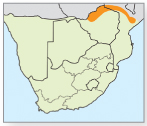

© R. BILLS
A slender, lightly built, translucent silver fish with scales that are easily shed. Has large eyes, a large mouth and short fins. Size: Reaches 140mm SL, but usually <100mm SL. Biology: They form enormous shoals in open waters in large lakes and dams, where they feed on plankton and are attracted to lights at night. Introduced to the region from Lake Tanganyika.
Knerias
Family Kneriidae
A small (30 species) exclusively African family of fishes, restricted to upland streams. Two genera occur: in Kneria, males have a distinctive ear-organ over the operculum and adjacent body, but Parakneria lack this feature. The ear-organ is a specialised clasper or sucker, used to secure breeding pairs during spawning.
1 Southern kneria
Kneria auriculata
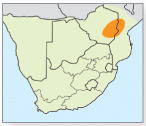
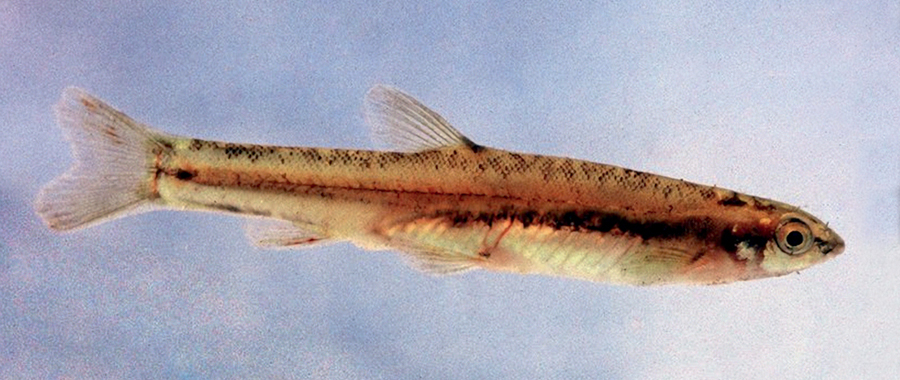
© P. SKELTON
Body slender and cylindrical, with rounded head, ventral mouth with scraping lower lip, short soft fins and fan-shaped pectorals. Male has sucker-like ear-organ on gill cover and adjacent flanks behind head. Size: Reaches 70mm SL. Biology: Lives in rocky pools and feeds by scraping diatoms and algae from rocks and plants. Male clasps female using the ear-organ when spawning. RELATED SPECIES: Mpumalanga kneria (an undescribed Kneria species) is an isolated relict known from a few streams in the Elands–Incomati system. Differs in mouth form from Southern kneria.
Carp, yellowfishes, mudfishes and minnows
Family Cyprinidae
This is the largest vertebrate family on Earth, with nearly 3,000 described species, of which 150 occur in southern Africa. Cyprinids, like catfishes and characins, have a Weberian apparatus – a complex modification of the first few vertebrae to form a connection between the swim bladder and the inner ear. The Weberian apparatus detects sounds and pressure waves. Polyploidy (multiple sets of chromosomes), including tetraploidy (four sets) and hexaploidy (six sets), is characteristic of some southern African cyprinids.
2 River sardine
Mesobola brevianalis


© P. SKELTON
Slender, with large terminal mouth, large eyes, and dorsal fin placed behind midpoint (over origin of anal fin); anal fin has long base. Scales small and easily shed. Size: Reaches 75mm SL. Biology: Shoals in inshore and open waters, feeding on small invertebrates in the water column. RELATED SPECIES: Orange River sardine (M. gariepinus) occurs only below Augrabies Falls, and has a longer anal fin with more rays (15–17), larger scales and different gill structure.
3 Southern barred minnow
Opsaridium peringueyi


© P. SKELTON
Body spindle-shaped, with large head, eyes and mouth and large dorsal and anal fins. Anal fin in mature fish has extended anterior lobe. A series of simple bars mark flanks. Male becomes orange-red on head and chest in breeding dress. Size: Reaches 90mm SL. Biology: Favours clear flowing water, shoaling in shallow water over gravel or sand. Feeds on terrestrial insects, drift and midwater organisms. RELATED SPECIES: Northern barred minnow (O. zambezense), from the Zambezi River, differs in shape and has more bars on the body.
4 Chubbyhead barb
Enteromius anoplus


© P. SKELTON
Body moderately deep, with rounded head, small mouth, one or two pairs of short barbels and a characteristic small pigment spot at midbase of caudal peduncle. Size: Up to 120mm SL. Biology: Lives in small upland streams, forming shoals in sheltered habitats. Feeds on small aquatic invertebrates. Males turn golden and spawn individually with females. Eggs are scattered in spawning arena. The current ‘E. anoplus’ may in reality comprise a number of closely related species. RELATED SPECIES: In the Marico barb (E. motebensis), a Western Limpopo species, breeding males develop nuptial tubercles on the head.
5 Hyphen barb
Enteromius bifrenatus
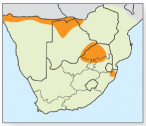

© P. SKELTON
A slender and fusiform (spindle-shaped) fish bearing two pairs of long barbels on the mouth. Has distinctive pigmentation: a solid or intermittent black lateral line, coupled with an arched black stripe together forming a ‘bow’ on the flanks. Size: Reaches 70mm SL. Biology: Found in slow-flowing clear streams and floodplain channels, feeding on small invertebrates and detritus.
6 Red barb
Enteromius fasciolatus


© P. SKELTON
Fusiform, rose to salmon body with a series of uneven vertical bars, including a short, broad, club-shaped bar on the anterior flanks; has two pairs of barbels. Size: Reaches 60mm SL. Biology: Inhabits well-vegetated habitats along gently flowing river margins, marshes, floodplain channels and lagoons. Most active in subdued light in the early morning and late evening.
1 Beira barb
Enteromius radiatus


© P. SKELTON
Spindle-shaped, with dorsal fin placed towards the head, and very short barbels; cheeks have pit lines (sensory pores) and scales have dark centres, creating a mesh pattern; fins are salmon to rose pink. Size: Up to 120mm SL. Biology: Inhabits swamps and marshy habitats; most active in subdued light in the early morning and late evening.
2 Sicklefin barb
Enteromius haasianus


© P. SKELTON
Hatchet-shaped, with a small mouth, no barbels and no lateral line. Transparent light brown in colour, with dark spots at the anterior base of the dorsal, anal and caudal fins. Mature male has markedly elongated sickle-shaped anal fin and assumes a deep rosy red nuptial dress. Size: Small (up to 35mm SL). Biology: Inhabits shallow well-vegetated swamps and floodplain marshes. Feeds on periphyton and small insects.
3 Threespot barb
Enteromius trimaculatus


© P. SKELTON
Robust, fusiform, silvery body with three widely separated spots on flanks, the last at base of caudal fin; dorsal fin has strong bony spine. Mouth with two long barbels. Size: Up to 150mm SL. Biology: Inhabits rivers and dams with vegetated margins. Feeds on invertebrates across the water column, from the surface to the bottom sediments. RELATED SPECIES: Closely related to the Dashtail barb (E. poechii), which has one black dash at base of tail and occurs in the Okavango Delta and upper Zambezi.
4 Orangefin barb
Enteromius eutaenia

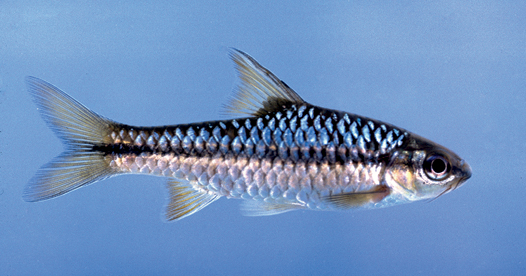
© P. SKELTON
A fusiform (spindle-shaped) barb, with mouth bearing two pairs of well-developed barbels. Dorsal fin has a strong serrated spine and a sheath of enlarged dark scales at its base. Broad black mid-lateral line runs from tip of snout to caudal fin. Fins yellow to orange. Size: Up to 140mm SL. Biology: Prefers flowing water in rocky habitats, or vegetated margins of flowing rivers and floodplain channels. Feeds from surface or midwater on insects and small organisms in the drift.
5 Straightfin barb
Enteromius paludinosus
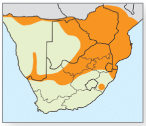

© P. SKELTON
Spindle-shaped, with small mouth and two pairs of short barbels. Dorsal fin is high, its leading ray serrated distally and its hind edge conspicuously straight and vertical when erect. Colour variable – mostly nondescript silver-grey. Size: Up to 150mm SL. Biology: Hardy and frequents quiet or slow-flowing marginal waters in lakes, marshes and larger rivers. Feeds on insects and small organisms. Female scatters eggs in aquatic vegetation.
6 Papermouth
Enteromius rapax

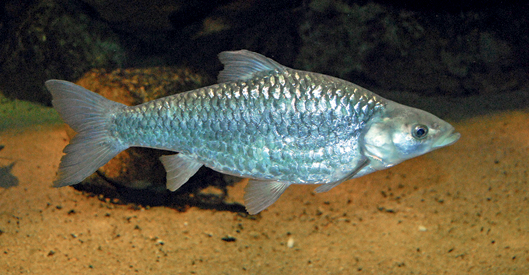
© P. SKELTON
Fusiform (spindle-shaped) plain silvery body, with two pairs of barbels and large eyes; terminal mouth can be thrust out; larger individuals have prognathous (projecting) lower jaw. Size: Reaches 400mm SL. Biology: Favours pools and dams along larger rivers. Feeds on invertebrates and small fishes at the surface or midwater. After the first rains in spring, migrates upstream to breed. RELATED SPECIES: Barbus mattozi from the Kunene River differs in coloration.
7 Clanwilliam redfin
Pseudobarbus calidus


© D. WOODFORD
A fusiform redfin; head has large eyes and a terminal mouth, with two pairs of well-developed barbels; dorsal fin has a serrated spine and originates behind the pelvic fins; anal fin has six branched rays. Silver-gold, with dark blotches on the back and a dark lateral band. Size: Reaches 82mm SL. Biology: Inhabits clear rocky pools and open waters of large tributary streams. Feeds in midwater and at the surface on invertebrates from the drift. Breeds in early to midsummer. Males swarm in breeding shoals over large rocks in running water, group spawning with females that lay eggs in rock crevices and joints. RELATED SPECIES: Twee River redfin (Barbus erubescens) has seven branched anal fin rays and is restricted to a tributary of the Doring–Olifants system in the Cederberg.
1 Border barb
Pseudobarbus trevelyani


© P. SKELTON
Body fusiform, with small mouth situated before end of head and bearing two short barbels. Dorsal fin ray has weak serrations. Usually silvery-grey, with a thin longitudinal stripe and black pigment along lateral line, forming ‘bow’ pattern. Size: Up to 95mm SL. Biology: Inhabits pools and rocky runs in upland streams. Feeds on stream insects in the drift and bottom-dwelling invertebrates. Breeding males and females both develop small tubercles on their heads, and spawn in groups in running water. RELATED SPECIES: The Clanwilliam redfin (P. calidus) (see p.102, 7) from the southwestern Cape has red bases to its pectoral and pelvic fins.
2 Sawfin
Pseudobarbus serra
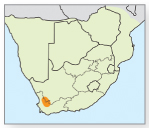

© D. WOODFORD
Has spindle-shaped body, becoming deeper with age. Large head with long snout; mouth is situated back from end of head and bears two pairs of barbels. Dorsal fin originates behind pelvic fins; dorsal fin ray is bony with strong serrations; anal fin has five branched rays. Juveniles silvery, with dark blotches on sides and back, becoming olive to brazen gold as adults. Small scales. Size: Up to 500mm SL. Biology: Shoals in deep pools and runs, feeding on invertebrates taken across the water column, from the surface to the bottom sediments. Feeding tracks (pockets) on sand bars indicate places where they dig into the sand to feed on molluscs and insects. Breed in summer, males forming large breeding shoals over rock or gravel runs and group spawning with the females, which scatter their eggs.
3 Witvis
Pseudobarbus andrewi


© P. SKELTON
Fusiform, becoming deeper-bodied with age. Head large with very long snout; mouth situated before end of head, with two pairs of barbels. Dorsal fin located at level of pelvic fins; dorsal spine with weak serrations and anal fin with six branched rays. Juveniles silvery, with dark patches on back and upper sides; adults brazen olive. Size: Attains 600mm SL. Biology: Juveniles found in rocky tributaries; adults in deep rocky pools and runs in mainstream rivers and in dams. Feed on invertebrates taken mostly from bottom sediments. In summer, males form large breeding shoals at the head of a pool over cobble and gravel beds. Spawn in groups, with eggs and sperm scattered over substrate.
4 Maloti minnow
Pseudobarbus quathlambae


© P. SKELTON
Body slender, elongate, covered in very small scales. Has smooth rounded head with non-terminal mouth bearing a single pair of short barbels. Countershaded – dark brown to bluish-grey above, with parallel lines of black spots along the back before the dorsal fin; creamy-white ventrally. Size: Up to 130mm SL. Biology: Lives in low-gradient high-altitude streams in the Drakensberg and Maloti mountains. Feeds on stream insects. They spawn in summer over crevices between rocks. Juveniles shoal in sheltered marginal habitats; adults forage alone or in small groups.
5 Burchell’s redfin
Pseudobarbus burchelli
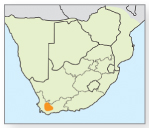

© C. GARROW
A moderately deep fusiform redfin; mouth under end of snout and carries two pairs of barbels. Dorsal fin has soft rays. Bright red bases to fins. Black patches on sides and back form variable lateral band ending in a triangular patch at base of caudal fin. Mature male develops large white nuptial tubercles. Size: Reaches 135mm SL. Biology: Lives in pools and runs of mainstream rivers and larger mountain tributaries. Feeds on detritus, algae and invertebrates taken mostly from the substrate, and opportunistically from the drift and surface. Breeds in summer. Males defend breeding territory, using sounds and behaviour. Juveniles form shoals; adults occur in smaller groups. RELATED SPECIES: Berg River redfin (P. burgi) found in the Berg River has smaller lateral pigment patches, a shorter anterior barbel and more, and smaller, nuptial tubercles in male.
6 Eastern Cape redfin
Pseudobarbus afer
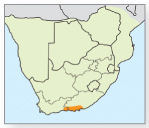

© D. WOODFORD
A moderately deep fusiform redfin. Mouth under end of snout, carrying single pair of barbels. Dorsal fin with soft rays. Base of fins bright red; body brown above, silvery on sides and white below. A variable dark mid-lateral band usually runs from below dorsal fin to base of caudal fin; some populations have small dark spots in two parallel lines in front of the dorsal fin. Size: Reaches 110mm SL. Biology: Inhabits clear pools and runs of mountain tributaries. Feeds on detritus and algae, as well as insects and small invertebrates. Breeds in summer, the smaller darker male developing prominent white nuptial tubercles on head. Juveniles form schools; adults forage alone or in small groups. RELATED SPECIES: The smaller, more brightly coloured Fiery redfin (P. phlegethon) occurs in the Clanwilliam–Olifants system.
1 Smallmouth yellowfish
Labeobarbus aeneus


© P. SKELTON
Deep fusiform body covered with relatively small scales. Head rises towards nape, with mouth situated before end of head. Lips vary from narrow sharp-edged razor lips to globular and fleshy rubber lips. Snout short with two pairs of barbels. Gap from eye to gill cover groove is equal to, or less than, width of gill cover. Dorsal fin has a bony and spinous ray, and its origin is behind pelvic fin. Juveniles silvery with dark patches; adults brazen green to bright yellow. Size: Reaches 500mm SL. Biology: Found in wide range of habitats from rapids to deep pools and runs in larger rivers. Thrives in large impoundments. Omnivorous, feeding from the substrate to midwater and surface waters on invertebrates, including mussels and snails, insects and small crabs, as well as detritus, diatoms, algae and even plankton. Move upstream in early summer to breed, males developing nuptial tubercles and congregating in masses to group spawn over gravel or rocky runs and riffles.
2 Largemouth yellowfish
Labeobarbus kimberleyensis


© P. SKELTON
Extended fusiform body is covered with small scales. Head large and relatively flattened from top to bottom, with terminal mouth, large lips and two thin pairs of barbels. Has wide gap between the eye and the gill cover groove. Dorsal ray bony and spinous, the dorsal fin placed directly above the pelvic fin. Juveniles silvery; adults remain silver-grey, but darker above. Size: Attains 825mm SL. Biology: Inhabits deep open channels of larger rivers and open waters of lakes. Preys on invertebrates, including crabs, becoming increasingly piscivorous at larger sizes. Matures at about 450mm SL, about eight years of age. They move upstream to breed in summer, but breeding sites and habits not known.
3 Clanwilliam yellowfish
Labeobarbus capensis

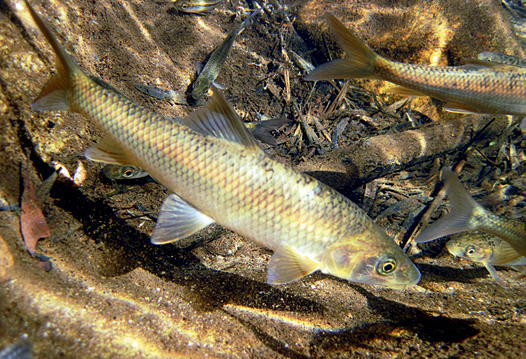
© C. GARROW
Has deep fusiform body covered with small scales. Mouth is situated under end of snout, with variable lips – may have thin and sharp-edged or globular and fleshy rubber lips. Dorsal fin is situated at level above or slightly before pelvic fin, and primary dorsal ray is segmented and flexible. Anal fin is extended in large adults. Juveniles silvery with dark patches; adults are brazen olive, turning deep golden in breeding dress. Size: Reaches 987mm SL. Biology: Inhabits pools and deep runs in large rivers, as well as dams and weirs. Omnivorous, feeding on a wide variety of organisms, algae and detritus, as well as bivalves and other molluscs from mud and sandbanks, and when larger, preying on small fishes and frogs. Congregate upstream when the river is in spate to breed over gravel beds. Males gather in breeding schools near the gravel beds and spawn collectively with gravid females.
4 Lowveld largescale yellowfish
Labeobarbus marequensis


© P. SKELTON
A fusiform yellowfish with large scales. Mouth situated under end of snout, with variable lips (slender and sharp-edged to globular and fleshy) and two pairs of short barbels. Dorsal fin situated at level in front of pelvic fins; dorsal ray flexible and segmented. Silvery to light golden in colour, with dark grey fin membranes. Size: Up to 470mm SL. Biology: Favours flowing reaches of tributaries and mainstream river courses. Prefers rocky stretches, but also found in sandy runs, soft-bottomed pools and impounded waters. Omnivorous, grazing on algae and detritus as well as a range of invertebrates, from insects to molluscs and crabs. Breed over gravel and cobbles in running water, typically with the smaller (from about 100mm SL) males congregating and group spawning with larger females (usually >280mm SL). RELATED SPECIES: Upper Zambezi yellowfish (L. codringtonii) differs in coloration, adults being blue-grey with salmon-pink flush.
1 Moggel
Labeo umbratus


© P. SKELTON
Has slender, fleshy, soft, fusiform body with small scales, rounded head, small ventral mouth and variable lips. Grey with scattered pink and dark grey highlights dorsally, cream to white ventrally. Size: Reaches 500mm SL. Biology: Prefers quiet slow-flowing or standing waters; common in weirs and impoundments. Feeds on detritus and soft sediments. Congregate and migrate upstream to breed en masse; eggs are scattered and stick to substrate.
2 Orange River mudfish
Labeo capensis

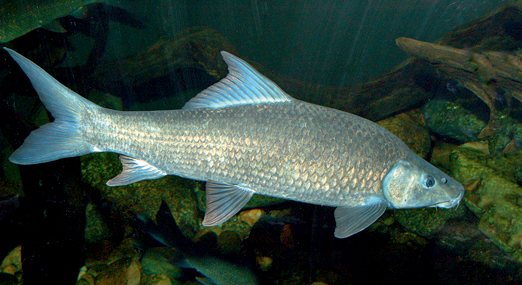
© C. GRIFFITHS
Body fusiform with small scales. Nape rises sharply in larger specimens; head large with ventral mouth and fleshy lips. Juveniles silvery; adults darker and appear bluish black in breeding coloration. Size: Reaches 500mm SL. Biology: Favours rocky running waters of larger mainstream rivers. Feeds on algae, diatoms and periphyton off rocks and firm substrates. Congregate and migrate upstream to breed en masse over gravel or cobbles in rocky riffles and rapids.
3 Clanwilliam sandfish
Labeo seeberi

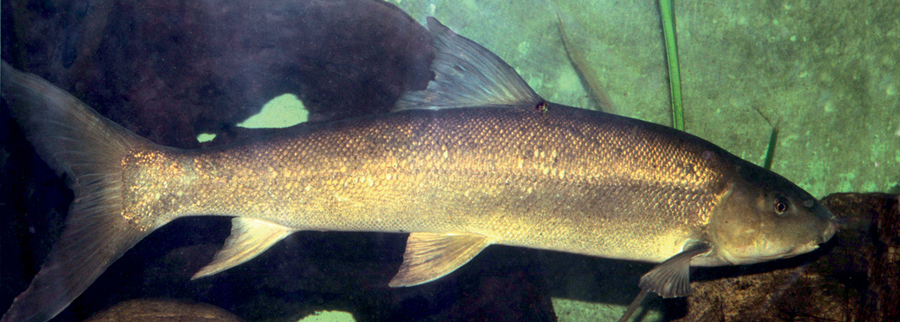
© P. SKELTON
Slender and elongate, with very small scales. Has rounded head, small eyes and ventral mouth with rough lips. Coppery silver-grey above, white below. Size: Reaches 355mm SL. Biology: Prefers deep open water, over sand or rocks in larger rivers. Feeds on algae and periphyton. Congregate and migrate upstream to breed.
4 Manyame labeo
Labeo altivelis
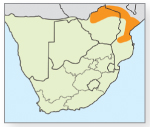

© R. BILLS
Body deep with medium-sized scales, short head and ventral mouth, with fine reddish tubercles on snout. Dorsal fin large, with irregular hind edge. Brazen green, with pinkish flanks and dark grey fin membranes. Size: Reaches 410mm SL. Biology: Prefers open sandy reaches of larger lowveld rivers, and thrives in dams and weirs. Feeds on algae and periphyton from firm substrates. Strong swimmers, migrating upstream to breed.
5 Redeye labeo (Golden mudsucker)
Labeo cylindricus


© P. SKELTON
Slender and cylindrical in shape, with large head, characteristic red eyes, a prominent snout with star-shaped horny tubercles (especially in larger individuals) and a large mouth, with deep fleshy fold in front and a sharp scraping edge on lower lip. Olive green to yellow above, frequently with a broad darker lateral band, cream or white below. Size: Up to 230mm SL. Biology: Rheophilic (current-loving), favouring rocky cascades and runs, as well as rocky lakeshores. Grazes surface algae from rocks, leaving characteristic tracks. Migrate upstream to breed en masse, ascending low barriers by climbing moist rocks, using their mouths as suckers.
6 Carp
Cyprinus carpio


© C. GRIFFITHS

© P. SKELTON
Deep-bodied; mouth, situated before end of head, can be thrust out and has slender lips and two pairs of short barbels. Long-based dorsal fin extends back to above anal fin; dorsal and anal fins have serrated leading spine. Scales variable – three forms found on different fish: full scaled (normal), mirror carp (6a) (scattered large scales) and leather carp (scaleless or naked). Colour usually brazen olive, but highly variable; domestic strains occur. Size: Attains more than 1m TL, and >20kg. Biology: Favours quiet waters of large rivers, dams and lakes. Feeds off soft sediments, stirring them up and making waters turbid. Lays eggs on submerged vegetation. Popular pets in garden ponds (koi), as well as important angling targets. Farmed for food in many countries and introduced to South Africa in 1859. RELATED SPECIES: Goldfish (Carassius auratus) are smaller, lack barbels and have become feral in many urban streams.
7 Grasscarp
Ctenopharyngodon idella
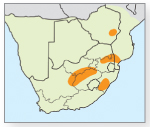

© P. SKELTON
Body elongate and cylindrical, covered in large regular scales. Has pointed head, eyes set low and well forward and mouth situated before end of head. Silvery with olive undertones and small grey fins. Size: Large, attaining >1m TL and >40kg. Biology: Prefers quiet well-vegetated habitats in large rivers and dams. Feeds primarily on plants, but also takes insects and other invertebrates. Breed in rising water over flooded habitats; eggs are buoyant and float downstream with receding floodwaters.
Distichodontids
Family Distichodontidae
An exclusively African family, comprised of about 90 species found in tropical waters. Members are characterised by having two rows of teeth, and rough (ctenoid) scales.
1 Chessa
Distichodus shenga


© R BILLS
Deep, compressed, ovoid body, with steep convex nape, small head, and small mouth below head. Juveniles silvery, with 12–16 bars on the flanks; adults assume a uniform silver-olive hue and fins become sooty. Size: Attains 500mm SL. Biology: Shoal over rocks and sand in large rivers, preferring gently flowing reaches. Omnivorous, feeding on a wide variety of foods, including algae and plants, as well as invertebrates like molluscs and small fish. Move upstream in swollen rivers to breed.
2 Dwarf citharine
Nannocharax machadoi


© P. SKELTON
Body slender, spindle-shaped, with large eyes and small terminal mouth. Has broad bars on body and several bars on caudal fin, plus prominent black spot at base of caudal fin. Size: Up to 40mm SL. Biology: Inhabits thick vegetation in swamps and floodplains or along river margins. Feeds by picking tiny organisms from stems and leaf surfaces. Breeding biology unknown. RELATED SPECIES: Multibarred citharine (N. multifasciatus), also in upper Zambezi region, has small adipose fin, more numerous bars on body and single dark bar on caudal fin.
African pikes
Family Hepsetidae
A small family of five species of moderately large distinctive predators found in tropical Central and West Africa. Most probably related to the ctenolucid pikes of South America.
3 Southern (African) pike
Hepsetus cuvieri


© P. SKELTON
A streamlined pike, with large pointed head, prominent jaws, with exposed irregular canine teeth, median fins placed well behind midbody and a small adipose fin. Three prominent stripes behind the eye are a characteristic feature. Size: Reaches 470mm SL. Biology: Inhabits quiet waters along well-vegetated margins of lagoons, mainstreams and floodplain channels. Ambush predator; feeds on invertebrates (when small) and other fishes. Breeding pairs create a floating foam nest in dense vegetation; eggs float into the nest and larvae hang until free-swimming. Both parents guard the nest and larvae.
Robbers and tigerfishes
Family Alestidae
The fishes in this large African family (over 100 species) are characterised by their strong jaws and sharp teeth. They are active midwater swimmers.
4 Imberi
Brycinus imberi


© P. SKELTON
Fairly stout deep body, flattened from side to side; mouth terminal, with two rows of tricuspid (outer) or multicuspid (inner) teeth. Dorsal fin at midbody, anal fin broad (and in males the median rays are extended), small flat adipose fin and forked caudal fin. Scales large, in even rows. Body silvery with a dark spot behind head and black bar framed by yellow on caudal peduncle, adipose fin orange. Size: Attains 180mm SL. Biology: Favours flowing water, but also in large impoundments. Feeds on a wide variety of organisms, from invertebrates to small fish, and favours terrestrial insects. In summer they migrate up flooded rivers to breed.
5 Tigerfish
Hydrocynus vittatus

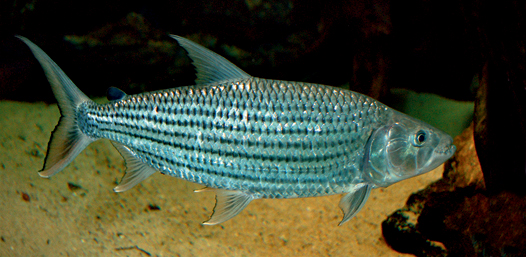
© C. GRIFFITHS
Spindle-shaped, with large bony head, prominent jaws with characteristic, exposed, interlocking canine teeth and a deeply forked tail. Silver-blue with series of semi-parallel black stripes along flanks and upper body. Size: Reaches 700mm SL. Biology: Shoal in open water, actively hunting and pursuing prey. Small juveniles feed on insects; adults progress to a fish diet and become so strong and agile that they can even take swallows in flight. Worn or broken teeth are replaced throughout life. Breed in rain-swollen rivers during summer, moving upstream and spawning en masse over flooded margins and rocky runs.
6 Silver robber
Micralestes acutidens


© P. SKELTON
A fusiform (spindle-shaped) fish; mouth with two rows of sharp multicuspid teeth. Silvery, with sooty black tip to dorsal fin. Male has extended anterior anal fin rays. Size: Up to 80mm SL. Biology: Shoals in flowing waters, often along river margins, feeding on insects from the surface, or on drift organisms from water column. RELATED SPECIES: Zambezi striped robber (Brycinus lateralis) is larger and has a black bar at base of caudal fin.
Southern catfish
Family Austroglanididae
Small family comprising three species of small riverine catfish from the Orange and Olifants rivers in southern Africa, and whose relationships to other catfish families are not yet clear.
1 Clanwilliam rock-catfish
Austroglanis gilli


© C. GARROW
Slender-bodied with dorsal fin positioned forward, close to the head. Dorsal and pectoral fins with strong spines; adipose fin well developed. Has small eyes on top of the head, mouth situated before end of head and fleshy lips with three pairs of barbels. Size: Reaches 164mm SL. Biology: Nocturnal, living between cobbles in pools and runs, in larger streams and rivers. Feeds on invertebrates.
Grunters
Family Claroteidae
A diverse family comprising 14 genera of moderately elongated tropical African catfishes. The African subfamily Auchenoglaninae includes about 20 species, which are unique in having anterior openings to nostrils inside the upper lip.
2 Zambezi grunter
Parauchenoglanis ngamensis


© R.BILLS
Head large, with terminal mouth, fleshy lips, three pairs of mouth barbels and a pair of nasal barbels. Openings to nostrils situated inside upper lip. Dorsal and pectoral fins have strong spines. Has large adipose fin. Spotted all over, with characteristic pattern of 5–7 distinct vertical rows of spots on body. Size: Reaches 380mm SL. Biology: Lives in crevices in rocky habitats, as well as in rootstocks and bankside structures, often in flowing water. Omnivorous, feeds on invertebrates, including snails and small fishes. Grunts loudly when removed from the water.
Sand catlets and mountain catfishes
Family Amphiliidae
A diverse family comprising 12 genera and 94 species of mostly small African catfishes, which inhabit various habitats in flowing water. In all species the swim bladder is reduced to two chambers on the sides of the neck, behind the head.
3 Spotted sand catlet
Zaireichthys conspicuus


© P. SKELTON
Short stout-bodied sand catlet with eyes on top of head, short barbels, dorsal fin with short spine, pectoral fins with serrated spine and large adipose fin. Blotched with shades of brown over creamy-white background. Size: Reaches 35mm SL. Biology: Lives in shallow sandbanks, usually buried just beneath the surface, with only eyes protruding. Feeds on small invertebrates carried by the current.
4 Stargazer mountain catfish
Amphilius uranoscopus
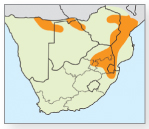

© P. SKELTON
Depressed head with eyes situated at the top. Dorsal and pectoral fins lack spines; pectoral fins large and rounded, with padded comb-like leading ray. Has grey, dark brown or black mottling. Size: Up to 170mm SL. Biology: Prefers fast-flowing water of rocky cascades, rapids, riffles or runs in upland streams. Feeds on invertebrates. RELATED SPECIES: The Natal mountain catfish (A. natalensis) is more slender; found in streams on the Drakensberg and Mpumalanga escarpment.
Butter catfishes
Family Schilbeidae
A distinctive Afro-Asian family of about 60 species of midwater-shoaling catfishes with compressed bodies, very short dorsal fins and long-based anal fins. Move slowly, with undulations of long anal fin.
5 Silver catfish (Butter barbel)
Schilbe intermedius


© P. SKELTON
Tapered, compressed, with short dorsal fin and extended anal fin. Dorsal and pectoral fins have slender sharp spines. Large depressed head, with large terminal mouth and long slender barbels. Colour variable: usually plain silver or with broad dark brown longitudinal bands and large dark spot behind head. Size: Attains 300mm SL. Biology: Shoals quietly in still backwaters, vegetated lagoons and dams. Active at night; preys on invertebrates and fishes from water column.
Electric catfishes
Family Malapteruridae
An exclusively African family comprising about 20 species in two genera, occurring in tropical waters. Body muscles modified into a powerful electrogenic organ capable of generating several hundred volts of electric power.
6 Electric catfish
Malapterurus shirensis


© R. BILLS

© P. SKELTON
Rotund and soft-bodied, lacking rayed dorsal fin. Pectoral fins lack spines. Anal and adipose fins far back, near caudal fin (6a). Grey above, cream below, with irregular black spots and blotches. Size: Up to 500mm SL. Biology: Sedentary; in sheltered cavities in rocks or among submerged bankside roots, fallen tree stumps and vegetation. Feeds mainly on fishes, stunning prey with an electric jolt. Electric organ consists of modified muscles in a layered sheath around the forebody.
Air-breathing catfishes
Family Clariidae
A large family of 118 species that are widespread in tropical Africa and southeast Asia. They breathe air using a tree-like accessory air-breathing organ situated in a chamber above the gill arches. Three genera and eight species in region.
1 Sharptooth catfish
Clarias gariepinus


© C. GRIFFITHS
Body laterally compressed towards tail. Head large, heavy and flattened, with eyes near the front and four pairs of long slender barbels. Mouth large, with broad band of fine teeth in each jaw. Pectoral fins with serrated spine. Well-developed air-breathing organ in chamber behind head. Size: Attains 1.4m SL and >50kg. Biology: Hardy; favours floodplains and marshes. Survives habitat desiccation by breathing air and, if necessary, moves overland between pools at night. Forages alone or in packs. Omnivorous, taking plankton, larger invertebrates and aquatic and terrestrial vertebrates. Mass in large groups to breed on shallow, flooded, grassy margins of lakes and rivers. Fast-growing; long-lived. Africa’s most widespread freshwater fish.
2 Vundu
Heterobranchus longifilis


© C. GRIFFITHS
Head large, with very long barbels. Rayed dorsal fin reduced to half length of the back and followed by large adipose fin. Air-breathing organ well developed. Deep reddish or olive brown; cream to white ventrally; adipose fin black at tip, caudal fin has light band. Size: Attains 1.2m SL and >50kg. Biology: In deep mainstream pools and standing waters in large rivers, dams and lakes. Diet varied, from insects to vertebrates (fishes, frogs and even young crocodiles and birds). Long-lived, reaching 12 years or more.
3 Snake catfish
Clarias theodorae


© P. SKELTON

© P. SKELTON
Elongate and slender, with small head and long barbels (3a); dorsal and anal fins reach to base of caudal fin. Dark brown to black, with lateral-line pores highlighted white. Size: Reaches 350mm SL. Biology: Prefers dense vegetation in swamps, floodplain marshes and along river margins. Feeds on invertebrates and small fishes.
4 Cave catfish
Clarias cavernicola


© R. STOBBS

© C. MAXWELL
Long and slender, with small head; eyes may be vestigial or absent. Pinkish-white. Size: Attains 160mm SL. Biology: Inhabits a single underground cave lake (4a, habitat image). Feeds on detritus, including bat droppings, insects and animal remains.
Squeakers and suckermouths
Family Mochokidae
The largest African family of catfishes, with over 200 recognised species. Two genera in southern Africa: Synodontis, known as ‘squeakers’ for the rasping sound they make when removed alive from the water, and Chiloglanis, known as ‘suckermouths’ for their disc-like mouths.
5 Brown squeaker
Synodontis zambezensis


© P. SKELTON
Deep body, pointed head and small mouth. Jaws have barbels with long slender branches. Dorsal fin is tall, pectorals large, and dorsal and pectoral fins each have strong serrated spine. Plain greyish brown; some with small round spots. Size: Attains 300mm SL. Biology: Varied diet includes detritus, algae, plants, insects and small fishes. RELATED SPECIES: Spotted squeakers (S. nigromaculatus) from the Kunene, Okavango and upper Zambezi rivers and from Chambeshi system differ in colour, being green with black spots over body and fins.
6 Largespot squeaker
Synodontis macrostigma


© P. SKELTON
A short stout squeaker; barbels on jaws have stubby branches. Large dark brown or black spots cover body. Size: Attains 170mm SL. Biology: Nocturnal, resting in a sheltered place during daylight hours. Omnivorous, it forages in bottom sediments, eating plants, snails and small fishes. RELATED SPECIES: Upper Zambezi squeaker (S. woosnami) from upper Zambezi and Okavango systems differs in pigmentation (small spots and vermiculations) and teeth.
7 Pennant-tailed suckermouth
Chiloglanis anoterus


© P. SKELTON
Body stout. Eyes in superior position; snout slopes downwards; mouth a disc with short barbels. Fin spines short; caudal fin has even rays in females, irregularly extended rays in males. Size: Reaches 90mm SL. Biology: In rocky rapids and riffles, eating bottom-dwelling insects, like blackfly larvae and mayfly nymphs. RELATED SPECIES: Male Shortspine suckermouth (C. pretoriae) from Limpopo and Incomati river systems does not develop extended caudal rays.
Galaxias
Family Galaxiidae
These are small, semi-transparent, scaleless, midwater fishes from the southern continents and islands, including Africa, Australia, New Zealand and South America. Distantly related to salmonids. The family includes six genera and around 50 species, but modern molecular techniques are revealing a high number of cryptic species, including in South Africa.
1 Cape galaxias
Galaxias zebratus


© C. GARROW
Body slender, cylindrical and soft, without scales, transparent light brown with darker markings. Head long, with eyes forward and a large terminal mouth. Size: Attains 75mm SL. Biology: Inhabits streams and rivulets, as well as larger rivers, and remains within cover near banks, rocks or plant roots, feeding on small organisms from the drift. Is capable of cutaneous air respiration and is able to survive exposure in damp conditions. RELATED SPECIES: Recent studies show that this species in fact comprises a largely undescribed complex of 10–12 species.
Trout
Family Salmonidae
A northern hemisphere family of large cold-water predators famed for their angling qualities. Have large jaws, small scales and a small adipose fin. Some species are diadromous, migrating between fresh water and the sea; others spend their entire life cycle in fresh water. Two species are established in southern African rivers – the Brown trout from Europe and the Rainbow trout from North America.
2 Rainbow trout
Oncorhynchus mykiss
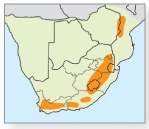

© C. GRIFFITHS
Body spindle-shaped and streamlined, covered in very small scales; mouth large and terminal, with fine teeth. Has soft fins, including a small adipose fin. Silvery in colour, with spots and an iridescent pinkish lateral band. Parr (juveniles) have about 10 light steel-grey vertical bars. Size: Reaches about 660mm SL in South Africa. Biology: Requires cool (<20°C), clear, well-oxygenated water in rocky mountain streams or upland dams. Cold flowing water also essential for breeding. Breed over gravel beds, females creating a spawning nest or ‘redd’ for eggs. Prey includes insects and larger invertebrates like crabs, frogs and fishes. In some streams it has decimated and even eliminated native fishes and frogs, as well as certain invertebrates. A very popular fly-fishing target and an important aquaculture species.
3 Brown trout
Salmo trutta


© C. GRIFFITHS
Body spindle-shaped and streamlined, with obtusely pointed head, small eyes and large terminal mouth with fine teeth. In breeding males lower jaw becomes enlarged and hooked. Fins soft; small adipose fin is present. Scales very small. Juveniles silvery-grey with dark bars along flanks. Adults golden brown, with clear deep red-and-black spots on flanks and sides of head; caudal fin plain grey. Size: Attains about 750mm SL in South Africa. Biology: Inhabits cold mountain streams and dams. Flowing, well-oxygenated and clear waters are required. Breeds in autumn or early winter over gravel beds, and feeds on wide range of prey from insects to crabs, small fishes and frogs, taken from the drift and across water column.
Killifishes
Family Nothobranchiidae
Small annual fishes, with brightly coloured attractive males and plain females. They live in temporary pools and ephemeral marshes, surviving the dry season in an embryonic state. They are popular aquarium fishes on account of their size, colour and behaviour.
4 Southern rainbow killifish
Nothobranchius pienaari


© B. WATTERS
Males predominantly blue, with vermillion-edged scales, oblique red bars on flanks, a distinctive black edge to the caudal fin and a prominent orange-yellow subterminal band. Females plain brownish. Size: Up to 40mm TL. Biology: Inhabits well-vegetated seasonal floodplain pools and marshes. Feeds on insects and small invertebrates. Breeds continuously in pairs, laying eggs in muddy bottom sediments. Development is arrested when habitat dries out, resuming when rains re-flood the pool. RELATED SPECIES: Rainbow killifish (N. rachovii) and Krysanov’s rainbow killifish, (N. krysanovi) differ in chromosome number and coloration. Rainbow killifish is brighter red and lighter blue; Krysanov’s killifish has orange caudal fin, with lighter subterminal band and broad black terminal band. Both occur north of Beira on the Zambezi floodplain.
Topminnows
Family Poeciliidae
Small fishes displaying two different breeding systems: African species (subfamily Aplocheichthyinae) are egg-layers; South American species (subfamily Poeciliinae), some of which have been introduced to South Africa, are live-bearers.
1 Johnston’s topminnow
Micropanchax johnstoni


© P. SKELTON
Slender, with supraterminal mouth, short dorsal fin placed far back over hind section of anal fin, caudal fin that ends with sloping blunt tip, and small pelvic fins in mid-abdomen. Brown above; silvery flanks have blue infusions and fins pale yellow with sooty edges. Size: Up to 50mm TL. Biology: Shoal in shallow well-vegetated waters on the shores of rivers, lagoons and floodplain marshes. Feed on small invertebrates from the surface. They lay eggs on vegetation. RELATED SPECIES: In Natal topminnow (M. myaposa) from Maputaland, male has bluish-black fins with a thin yellow-white edge.
2 Mosquitofish
Gambusia affinis


© P. SKELTON
Sexually dimorphic: male smaller and more slender than female, with anal fin placed forward (before midbody) and modified into long slender gonopodium (intromittent organ); female hatchet-shaped, with rounded abdomen and short anal fin placed in midbody. Both sexes transparent brown with bluish patches. Size: Male attains 35mm TL, female up to 60mm TL. Biology: Introduced from North America for mosquito control. Inhabits quiet marginal and vegetated habitats in pools or lagoons. Feeds on small organisms taken from the surface or upper water column. Male pursues female and inseminates her using the extended gonopodium; eggs and embryos develop internally to full term and are born live. RELATED SPECIES: Another introduced species, the guppy (Poecilia reticulata), differs in that male is multicoloured, with shorter gonopodium. Feral populations occur near towns and cities.
Bass and bluegills
Family Centrarchidae
A North American family of large, predatory, spiny-rayed fishes introduced to southern Africa from the 1930s and widely distributed for sport fishing and fodder. Established in many regions, they have severely impacted on indigenous fishes.
3 Largemouth bass
Micropterus salmoides


© P. SKELTON
A bold oblong bass, with highly extendible jaws and large gape. Dorsal fin in two parts – a spiny-rayed section separated by an indent from a posterior soft-rayed section. Has small scales and undivided lateral line. Olive, with irregular blackish lateral band. Size: Attains about 700mm SL. Biology: Prefers quiet water in dams, deep pools or the slow-flowing reaches of larger rivers. Highly predatory; juveniles are insectivorous; adults take crabs, fishes, frogs and other vertebrates. Mature males establish a territory and a nest area, guarding the eggs, larvae and young offspring. RELATED SPECIES: Florida bass (M. floridanus) is very similar in appearance and occurs in same range, but reaches a larger size.
4 Smallmouth bass
Micropterus dolomieu


© D.WOODFORD
A pointed oblong bass with large head and large extendible jaws. Dorsal fin in two parts, with a shallow indentation between spiny-rayed and soft-rayed parts. Olive, with darker bars along flanks and stripes along cheeks. Juveniles have black-and-yellow banded caudal fins. Size: Reaches 600mm TL in South Africa. Biology: Prefers pools in streams and flowing water. Preys on invertebrates when small; adults take larger organisms like crabs and fishes. Male cleans a nest area and guards the eggs, larvae and fry.
5 Spotted bass
Micropterus punctulatus


© C. GARROW
A slender oblong bass, with pointed head. Dorsal fin has spines and soft rays, and caudal fin has inward curve, but is not forked. Juveniles have dark lateral band of black bars and spots and sooty caudal fin with white edges. Adults olive above, with an irregular dark lateral band and a series of parallel stripes on the lower flanks. Size: Attains 600mm TL, but smaller in South Africa. Biology: Favours flowing water in smaller rivers. Preys on invertebrates and fishes. Male clears nest area and guards eggs, larvae and fry.
6 Bluegill sunfish
Lepomis macrochirus


© P. SKELTON
Deep ovoid, with prominent black lobe on top of gill cover. Spiny and soft-rayed sections of dorsal fin are continuous. Olive above, with barred silvery flanks; male assumes bluish ‘chin’ and reddish abdomen when breeding. Size: Reaches 350mm TL. Biology: Favours still, vegetated habitats, such as downstream dams and pools in larger rivers. Preys on invertebrates, small frogs and fishes. Male constructs saucer-shaped nest and guards eggs, larvae and fry.
Cichlids
Family Cichlidae
A large family (about 1,700 species) of tropical, spiny-rayed, freshwater fishes from South and Central America, Africa, Madagascar and India. In southern Africa there are about 45 species in 12 genera. Cichlids have spines in the dorsal and anal fins, a single nostril, a split lateral line and strong pharyngeal (throat) bones with teeth. Their breeding behaviours are varied and complex, and associated colour patterns in the males are often important taxonomic features.
1 Banded jewelfish
Hemichromis elongatus


© P. SKELTON
An oblong jewelfish with large head, large eyes and a terminal mouth that typically has two enlarged canines in upper jaw. Olive green with iridescent gold and turquoise scales on the sides, 5–6 broad vertical bars along the flanks, a broad oblique black bar through the eye and a white ventral surface that becomes bright red in breeding males (shown). Size: Attains 190mm TL. Biology: Found over sand along the shores of rivers and floodplain lagoons. Preys on insects, shrimps and small fishes. They are substrate spawners and nest guarders. RELATED SPECIES: Angolan jewelfish (H. angolensis) from the Cuanza River differs in coloration.
2 Southern mouthbrooder
Pseudocrenilabrus philander


© P. SKELTON
A tapered oblong fish with oblique bar through the eye from the cheek and rounded caudal fin. In mature males anal fin has orange tip. Coloration of males varies with locality. Size: Up to 130mm TL. Biology: Hardy, found in shallow, weedy, inshore reaches of rivers and standing waters, such as vleis and marshes. Preys on insects and small organisms. Mouthbrooder; male clears and defends nest; after spawning female gathers fertilised eggs in her mouth and moves offsite to brood. RELATED SPECIES: Cunene dwarf bream (Orthochromis machadoi) is red in colour and restricted to the Cunene system in Namibia and Angola.
3 Pink bream
Sargochromis giardi


© D.TWEDDLE
A robust, deep-bodied and deep-cheeked bream with a convex dorsal profile, large head and strong jaws, with two rows of conical teeth and mollariform (crushing) pharyngeal teeth. Male has numerous small red spots on anal fin. Size: Reaches 480mm TL. Biology: Prefers deep floodplain channels and lagoons, where it feeds on snails and mud- or sand-dwelling bivalves. Male clears round nests in beds of vegetation in deeper water; female lays, and then gathers eggs in her mouth. These are fertilised when she attempts to ‘gather’ the egg-like spots on the anal fin of the breeding male. Moves offsite to mouthbrood eggs and larvae.
4 Lowveld largemouth
Serranochromis meridianus


© P. SKELTON
Stout-bodied with deep cheeks and high eyes; mouth large, inclined, with fine conical teeth. Deep olive to golden yellow, fins dark with yellow edges. Males with rows of pink-orange egg spots on anal fin. Size: Reaches 310mm SL. Biology: Prefers quiet standing waters and thrives in impoundments. Preys on invertebrates and small fishes. Males build nest for spawning, females collected fertilised eggs and mouthbrood eggs and larvae.
5 Thinface largemouth
Serranochromis angusticeps


© N. SMIT
Highly compressed head and body, with large mouth and gape. Profile sharply concave in front of dorsal fin. Breeding male has bright yellow on head and forebody, with bars radiating from eyes, a red edge to dorsal fin and a yellowish anal fin, with small red egg spots. Size: Reaches 410mm TL. Biology: Prefers well-vegetated shallow habitats on floodplains or in swamps. Ambushes predators, feeding mostly on fishes. Females are mouthbrooders. RELATED SPECIES: The Humpback largemouth (S. altus) differs in colour (grey, lacking eye bars and has yellow dorsal lappets) and shape (deeper, broader, with more pronounced head kink). They occur together in the upper Zambezi.
6 Nembwe (Robbie)
Serranochromis robustus


© R. BILLS
Has robust oblong body with large head, deep cheeks, small eyes, large mouth and pointed well-spaced teeth. Size: Up to 450mm TL. Biology: Large adults prefer deeper mainstream and floodplain channels, lagoons and backwaters. They prey on fishes, including squeakers. Mouthbrooders, nesting along river margins. RELATED SPECIES: Most similar to the more slender Brownspot largemouth (S. thumbergi) from the Okavango and upper Zambezi.
1 Banded tilapia
Tilapia sparrmanii


© P. SKELTON

© E. ELLANDER
An oval tilapia, with a small mouth and truncated caudal fin. Olive with 8–9 sooty vertical bars along flanks, blue lips, a dark spot on gill cover and a dark ‘tilapia’ spot (eyespot) on soft dorsal fin. Size: Up to 230mm SL. Biology: Common in pools and quiet vegetated waters in rivers, floodplains and marshes. Omnivorous, taking detritus, insect larvae, snails and small crabs. They are substrate spawners and brood guarders, forming breeding pairs; male excavates nest, and parents (1a) guard eggs, embryos and fry.
2 Red-breasted tilapia
Coptodon rendalli


© P. SKELTON
A deep-bodied tilapia, with moderately large beak-like mouth and profile steep before dorsal fin. Olive above. Colour variable, reflecting environment. Light ventral surface becomes bright red in mature breeding fish; 5–7 broad lateral bars. Size: Reaches about 400mm TL. Biology: Prefers quiet deep backwaters and floodplain lagoons with emergent and floating vegetation. Feeds on insects, invertebrates and water plants, especially water lily leaves. Substrate spawners and guarders; breeding pairs excavate a large oval nest, with deep pocket-like brood chambers in which eggs are laid and guarded.
3 Mozambique tilapia
Oreochromis mossambicus


© P. SKELTON

© P. SKELTON
A moderately deep-bodied tilapia with large head, large mouth (protruded in adult male) and fine teeth. Juvenile silvery with slender bars on sides. Breeding male (3a) sooty grey to black with a prominent white throat and red pectoral rays. Size: Up to 400mm SL. Biology: Favours slow-flowing or standing open water with submerged vegetation and a sandy substrate. Tolerant of a wide range of salinities including sea water; common in East Coast estuaries. Feeds on bottom sediments, detritus and algae. Females are mouthbrooders; males build large saucer-like nests of vegetation on sandy shelves. Valued for food and aquaculture.
Labyrinth fishes
Family Anabantidae
A small family of about 30 species of spiny-rayed fishes from Africa and southern and southeast Asia that have labyrinth-like air-breathing organ in a chamber above the gill arches. Southern Africa has three genera and four species.
4 Many-spined climbing perch
Ctenopoma multispinis


© P. SKELTON
An ellipsoid perch with a pointed head, large eyes situated towards the front and hinged gill covers, with a scalloped spiny edge. Has long series of spines in both dorsal and anal fins. Well-developed air-breathing organ is situated above gills. Brown and black with radiating bars behind eye. Size: Up to 135mm SL. Biology: Favours shallow swamps and well-vegetated backwaters. Breathes air and can emerge from water to move overland. Preys on invertebrates and other small organisms, including fishes. Forms breeding pairs that scatter eggs over breeding arena without guarding or nesting.
5 Cape kurper
Sandelia capensis

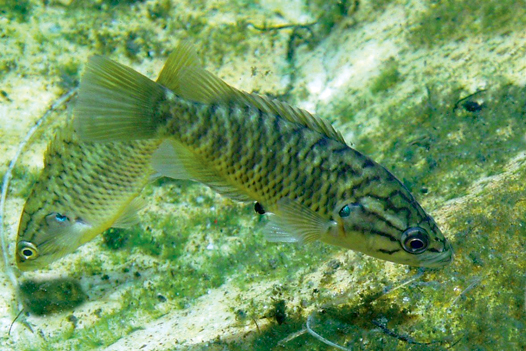
© D. IMPSON
An ellipsoid kurper with a pointed head, eyes placed forward and a distinct black notch on gill cover. Dorsal and anal fins have long series of spines. Brightly marked in brazen olive-gold with black scale bases and stripes behind eye. Size: Reaches 200mm SL. Biology: Favours sheltered habitats in clear flowing streams; has reduced non-functional air-breathing organ. Preys on insects. Males defend a breeding territory and guard the scattered developing eggs and larvae. RELATED SPECIES: The Eastern Cape rocky (S. bainsii) is a more sombre greyish green with a single suborbital bar. Occurs in streams arising from the Amatola Mountains and in the Kowie River.
Spiny eels
Family Mastacembelidae
An Afro-Asian family of about 84 species of eel-like fishes that have a series of spines along the back before a soft-rayed dorsal fin, which is confluent with the caudal and anal fin.
6 Longtail spiny eel
Mastacembelus frenatus


© P. SKELTON
Eel-like with a long head and a pointed snout extended into a nasal tentacle. Dorsal fin comprises a series of erectable spines along the back and includes a long soft-rayed section confluent with the caudal and anal fins; lacks pelvic fins. Variegated brown with light bilateral bands on the dorsal flanks and ocellations (eyespots) along the base of rayed dorsal fin. Size: Up to 300mm TL. Biology: Lives in rocky crevices and sheltered bankside habitats. May bury itself in sand and bottom sediments. Feeds on small invertebrates.